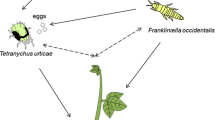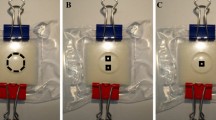We examined patch residence times for an omnivorous predator, Dicyphus hesperus on a variety of plants and prey. Individual D. hesperus were placed in cages containing either mullein, tomato, pepper or chrysanthemum plants, and either no prey, Mediterranean flour moth eggs, greenhouse whitefly pupae or two-spotted spider mite adults. Patch residence times were typically greater than 24 h. The probability of remaining on the patch was greatest on mullein and tomato, followed by chrysanthemum and least on pepper, whereas probability of remaining on the patch was greatest when flour moth eggs were present, and least when no prey were available. Patch residence time in D. hesperus was determined by both the prey, and the species of plant, in an independent fashion. Our results reinforce the notion that for omnivores, the patch itself is as important as the prey that it harbors.


Similar content being viewed by others
REFERENCES
Bell, W. J. (1991). Searching Behaviour: The Behavioural Ecology of Finding Resources. Chapman & Hall, New York.
Bernays E.A., and Chapman, R. F. (1994). Host-Plant Selection By Phytophagous Insects. Chapman & Hall, New York.
Chau, A., Heinz, K. M., and Davies, F. T. Jr. (2005). Influences of fertilization on population abundance, distribution, and control of Frankliniella occidentalis on chrysanthemum. Ent. Exp. Appl. 117: 27–39.
Eubanks M. D., and Denno R. F. (1999). The ecological consequences of variation in plants and prey for an omnivorous insect. Ecology 80: 1253–1266.
Gillespie, D. R., and McGregor, R. R. (2000). The functions of plant feeding in the omnivorous predator Dicyphus hesperus: Water places limits on predation. Ecol. Entomol. 25: 380–386.
Haccou, P., and Hemerik L. (1985). The influence of larval dispersal in the cinnabar moth, (Tyria jacobea) on predation by the red wood ant (Forma polyctena). An analysis based on the proportional hazards model. J. Anim. Ecol. 54: 755–769.
Jia, F., Margolies, D. C., Boyer, J. E., and Charlton, R. E. (2002). Genetic variation in foraging traits among inbred lines of a predatory mite. Heredity 89: 371–379.
Karban, R., Agrawal, A. A., and Mangel, M. (1997). The benefits of induced defenses against herbivores. Ecology 78: 1351–1355.
Lima, S., and Dill, L. M. (1990). Behavioral decisions made under risk of predation: A review and a prospectus. Can. J. Zool. 68: 619–40.
McGregor, R. R., Gillespie, D. R., Quiring, D. M. J., and Foisy, M. R. J. (1999). Potential use of Dicyphus hesperus Knight (Heteroptera: Miridae) for biological control of pests of greenhouse tomatoes. Biol. Control 16: 104–110.
Nakashima, Y., and Hirose, Y. (2003). Sex differences in foraging behaviour and oviposition site preference in an insect predator. Orius sauteri. Entomol. Exp. Appl. 106: 79–86.
Prokopy, R. J., Cooley, S. S., Prokopy, J. J., Quan, Q., and Buonaccorsi, J. P. (1994). Interactive effects of resource abundance and state of adults on residence of apple maggot (Diptera, Tephritidae) flies in host tree patches. Environ. Entomol. 23: 304–315.
Roitberg, B. D, Boivin, G., and Vet, L. E. M. (2001). Fitness, parasitoids, and biological control: An opinion. Can. Entomol. 133: 429–38.
Roitberg, B. D., Robertson, I., and Tyreman, J. (1999). Vive la variance: A new theory for the evolution of host selection. Entomol. Exp. Appl. 91: 187–194.
Sanchez, J. A., Gillespie, D. R., and McGregor, R. R. (2004). Plant preference in relation to life history traits in the zoophytophagous predator. Dicyphus. hesperus. Entomol. Exp. Appl. 112: 7–19.
SAS(1997). JMP IN 5.0. Sas Institute Inc., Cary, North Carolina.
Singer, M., and Bernays, E. (2003). Understanding omnivory needs a behavioral perspective. Ecology 84: 2532–2537.
Treacy, M. F., Benedict, J. H., Lopez, J. D., and Morrison, R. K. (1987). Functional response of a predator (Neuroptera: Chrysopidae) to bollworm (Lepidoptera: Noctuidae) eggs on smoothleaf, hirsute, and pilose cottons. J. Econ. Entomol. 80: 376–379.
van Alpen, J. J. M., Bernstein, C., and Driessen, G. (2003). Information acquisition and time allocation in insect parasitoids. Trends Ecol. Evol. 18: 81–87.
VanLaerhoven, S. L., Gillespie, D. R., and McGregor, R. R. (2000). Leaf damage and prey type determine search effort in Orius tristicolor. Entomol. Exp. Appl. 97: 167–174.
VanLaerhoven, S. L., Gillespie, D. R., and Roitberg, B. D. (2003). Diel activity pattern and predation rate of the generalist predator. Dicyphus. hesperus. Entomol. Exp. Appl. 107: 149–154.
VanLaerhoven, S. L., Gillespie, D. R., and Roitberg, B. D. (in review). Deconstructing effects of plant community on natural enemies. Ecol. Entomol.
ACKNOWLEDGMENTS
This research could not have been conducted without the assistance of D. Quiring, M. Miller, A. Laycock and L. Eckersley. We thank Applied Bionomics Ltd. (Sidney, BC) for providing the whitefly pupae used in experiments. This research was supported in part by the Biocontrol Network of the National Sciences and Engineering Research Council, the BC Greenhouse Vegetable Growers Association, Koppert Canada, University of Windsor, Simon Fraser University and Agriculture and Agri-Food Canada.
Author information
Authors and Affiliations
Corresponding author
Rights and permissions
About this article
Cite this article
VanLaerhoven, S.L., Gillespie, D.R. & Roitberg, B.D. Patch Retention Time in an Omnivore, Dicyphus hesperus is Dependent on Both Host Plant and Prey Type. J Insect Behav 19, 613–621 (2006). https://doi.org/10.1007/s10905-006-9047-y
Published:
Issue Date:
DOI: https://doi.org/10.1007/s10905-006-9047-y




